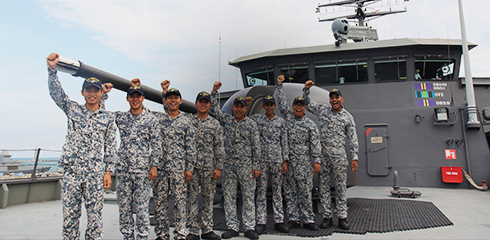Imagine this nightmare: an enemy vessel wreaking havoc in one of the most valuable of waterways in the world. Lives are lost, and billions of dollars’ worth of trade grind to a halt. How does Singapore respond? For one Republic of Singapore Navy (RSN) submarine crew, it starts with two words: action stations.
Following this, a voice comes over the submarine intercom, calmly laying out the mission.
“Now hear this. This is the commander speaking. We have been tasked to eliminate a hostile warship.”
Step One: Identify
After receiving her orders, the submarine uses smart sensors to zero in on her target — like a lionness sniffing out a gazelle. Sonar operators strain their ears, listening for acoustic signatures emitted by enemy subs or ships. So expert are these operators that they can ascertain the type of vessel based on sound characteristics alone. “This,” says SLTC Loh Mun Heng, Head of Submarine Training Centre, “is a skill that requires many years of training.” But a crucial skill — missing a sound could mean overlooking an enemy submarine that obliterates your crew.
Having identified the target, the torpedo crew springs into action, readying weapons for launch. Other teams zero in on the target’s course, speed and range, while the submarine steers to within firing range.
Step Two: Arm, Track, Evade
The real superpower of a submarine? Near-invisibility. As SLTC Loh puts it: “In most cases, the submarine will operate as a lone wolf to ensure her stealth and to retain the element of surprise. It is built to operate independently without any support for weeks.” Surface ships equipped with submarine-hunting sonar have no guarantee of rooting out a submarine — even when it’s right next to them.
That’s because the underwater environment is surprisingly chaotic. To find a submarine, a ship sends out an active sonar pulse, which they hope will reflect off the submerged lurker. But “there are many sources where sound energy may reflect back towards the ship: fish, air bubbles, dirt and the ocean bottom” to name just a few, says SLTC Loh.
In the meantime, the submarine evades detection by changing depth or course, turning like a sea snake so that it presents as small a target towards enemy sonar as possible. It also relies on passive sonar of its own, to detect neutral shipping and evade any other hostile vessels. All the while, the crew calmly readies its weapons. But time is ticking. Every second the hostile vessel exists, it remains a threat to our forces.
Step Three: Fire
The modern torpedo is as smart as it is deadly. Its nose is packed with sensors that track the range, bearing, course and speed of its target. But there’s a trade-off. These busy sensors can be counter-detected. The other option? Go passive, a quieter but less accurate solution.
The captain makes his choice. The target is locked.
“Firing solution is achieved on hostile warship,” barks a crewman. “Torpedoes ready for launch.”
The order comes: “Fire torpedoes!”
Once fired, “within minutes, the torpedo will reach the target and be allowed to home in for the final attack,” says SLTC Loh. And it doesn’t even need to make direct contact with a ship’s hull to sink it, SLTC Loh explains. Designed to detonate underneath the vessel thanks to a proximity fuse, the explosion creates a deadly “upthrusting gas bubble, which bodily lifts the hull out of the water.” Once the hull collapses back into the sea it cracks like an egg, and tonnes of water rush in.
The result: a confirmed kill for the submarine.
Action Stations
It takes a special type of warrior to crew a submarine. “At all times, the crew has to be vigilant in detecting, quick in identification and decisive in closing in on the target vessel,” says SLTC Loh. “In busy environments in our area, it is a daunting task.” But one that the RSN is ever ready to tackle, always alert for those two words: action stations.






